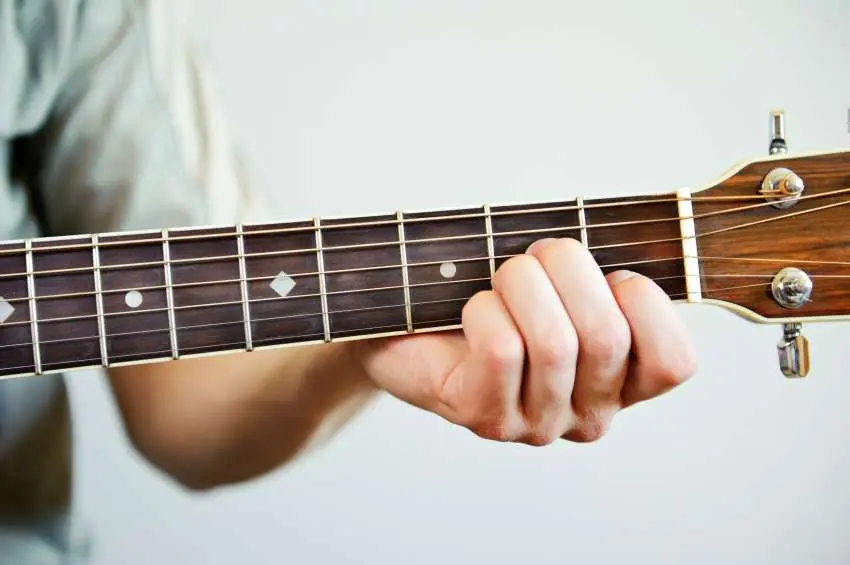
Scale in C major on guitar
“Tutorial” Guitar Lesson No. 19 What are guitar scales for?
The C major scale (C major) is the simplest scale on the guitar, but with the fingering of Andres Segovia, it will be of particular benefit to beginner guitarists. Unfortunately, many do not imagine the useful action of such a tedious activity as playing scales on the guitar. A guitarist who does not want to play scales resembles a crawling baby who does not want to walk, believing that moving on all fours is faster and more convenient, but whoever gets on his feet will learn not only to walk, but to run fast. 1. The scale in C major throughout the fretboard will give you a better idea of the location of the notes on the fretboard and help you remember them. 2. When playing scales, you will see synchronism in the work of the right and left hands. 3. Gamma will help to catch the feel of the neck and thereby develop accuracy when changing positions of the left hand. 4. Develop the independence, strength and dexterity of the fingers of the right and especially of the left hand. 5. Makes you think about the economy of finger movements and the correct positioning of the hands to achieve fluency. 6. Helps in the development of musical ear and sense of rhythm.
How to play guitar scales correctly
The first thing to do in order to play the scale correctly is to memorize the transitions from string to string and the exact sequence of the fingers of the left hand. Do not think that scales are just ascending and descending sounds and your task is to play them as quickly as possible in this way, building up technique. Such a vision of the task is doomed to failure from the outset. Scales are primarily passages of the pieces of music you play. You already know that music is not a chaotic change of passages and chords – all sounds are united by the tonality and rhythmic basis that allow us to call it MUSIC. So, the scale in the key of C major must have a certain size when performed. First of all, this is necessary in order to keep at a certain pace when playing without any slowdowns and accelerations. Accurate rhythmic performance in a certain time signature gives the passages beauty and brilliance. That is why scales are played in different sizes (two, three quarters, four quarters). This is how you should act when playing the scale, highlighting each first beat of the first measure of the time signature of your choice. For example, when playing in two beats, count one and two and marking with a slight accent each note that falls on “one”, count in three beats one and two and three and also noting the notes dropping out on “one”.
How to play the scale in C major on the guitar
Try to raise (raise) the fingers of your left hand above the strings as little as possible. The movements should be as economical as possible and this economy will allow you to play more fluently in the future. This is especially true for your little finger. The constantly rising little finger when playing scales and passages is an excellent “traitor” indicating the wrong position of the hand and forearm of the left hand in relation to the guitar neck. Think about the reason for such movements of the little finger – it is quite possible to change the angle of the hand and arm relative to the neck (change of landing) will give a positive result. Playing the scale in C major up
Place your second finger on the fifth string and play the first note C, keep your second finger on the string, place the fourth and play the note D. You play two notes, but both fingers continue to press the fifth string, while placing your first finger on the second fret of the fourth string and play the note mi. Just after playing mi on the fourth string, lift your fingers from the fifth to play f and g while holding the first finger on the note mi. After playing the G note, tear off the first finger from the fourth string and, placing it on the second fret of the third string, play the note la, and then tearing off the second and fourth fingers from the fourth string with the third finger, play the note si, continuing to hold the first finger on the note la (second fret). Just after playing the B notes, raise the third finger, while the first finger begins to slide easily along the third string to take its place on the XNUMXth fret. Pay special attention to this change of position on the third string, taking care that there is no uncontrolled sound interruption when the first finger moves to the fifth fret. I think that you have already understood the principle of performing the scale up and you can move on to the next step.
Playing the scale in C major down
You have played the scale on the first string to the note C, while the fingers of the left hand continue to stand in their places (1st on V, 3rd on VII, 4th on VIII frets). The principle of playing the scale in the opposite direction remains the same – as few extra finger movements as possible, but now, in order, tear off the fingers from the string and after the played note la on the XNUMXth fret, we will tear off the finger holding it only after we play the note G with the fourth finger on the XNUMXth fret of the second string .
Right hand when playing scales
Play scales with different fingers of the right hand first ( im ) then ( ma ) and even ( ia ). Remember to make small accents when hitting the strong beats of the bar. Play with a tight, loud apoyando (supported) sound. Play the scale on crescendos and diminuendos (increasing and weakening the sonority), practicing the shades of the sound palette. 
 You can learn the C major scale from the tablature below, but the main thing is to follow the fingerings written in the notes.
You can learn the C major scale from the tablature below, but the main thing is to follow the fingerings written in the notes.  Once you learn how to play the C major scale, play C sharp, D, and D sharp major. That is, if the gamma C major began from the third fret, then C sharp from the fourth, D from the fifth, D sharp from the sixth fret of the fifth string. The structure and fingering of these scales is the same, but when played from a different fret, the feel on the fretboard changes, making it possible for the fingers of the left hand to get used to these changes and feel the guitar neck.
Once you learn how to play the C major scale, play C sharp, D, and D sharp major. That is, if the gamma C major began from the third fret, then C sharp from the fourth, D from the fifth, D sharp from the sixth fret of the fifth string. The structure and fingering of these scales is the same, but when played from a different fret, the feel on the fretboard changes, making it possible for the fingers of the left hand to get used to these changes and feel the guitar neck.
PREVIOUS LESSON #18 NEXT LESSON #20





